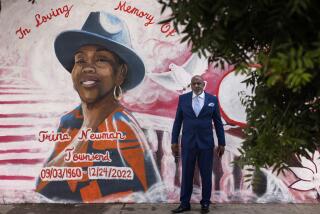Vietnam Seeks a Cap on Highway Deaths
- Share via
HANOI — With highway fatalities soaring to levels reminiscent of wartime body counts, Vietnam has said “enough” and implemented a safety program that targets the culprits and the victims of the carnage--motorcyclists without helmets.
The centerpiece of this campaign to cut road deaths and save an estimated $85 million a year in related costs is phasing in a mandatory helmet law, which, so far, just about everyone has ignored.
“Helmets won’t reduce the number of accidents, though they might reduce skull injuries,” said university student Thanh Lam, 22. “What officials should do is organize and manage traffic well, then let people decide if they want to wear a helmet. But I do agree there’s a problem.”
With only 8,530 miles of paved roads, Vietnam may well have the world’s deadliest highway system. Every day, about 20 people are killed on it--the equivalent of a fully loaded 747 jetliner crashing every three weeks--and about 40 people are left with brain damage or other permanent disabilities. Eighty percent of the victims ride 125-cc motorcycles.
The costs associated with the road carnage consume 90% of the national health budget and have so overwhelmed city hospitals that doctors have had to adopt triage systems. One hospital alone, Cho Ray in Ho Chi Minh City, loses an average of three patients a day as a result of motorcycle accidents. Safety experts say helmets would reduce the number of dead and injured by 80% to 90%.
“It seems insane for Vietnam to have made a huge investment in its people in social spending since the war, then to be losing a good part of the next generation to deaths that could be prevented,” said Greig Craft, an American who has lived in Hanoi since 1991 and has set up the Asia Injury Prevention Foundation. One of its goals is to provide motorcycle riders and passengers with specially designed helmets at cost.
Craft recently brought in his first shipment of more than 1,000 lightweight, vented helmets, made by Troxel Cycling & Fitness of San Diego. With a sturdy shell and extra foam to protect the skull, they cost less than $10 each--compared with $50 here for many imported helmets, an amount that stretches the budgets of even middle-class citizens, and $7 for locally made ones that can hardly withstand a hearty gust of wind, much less a collision at 20 mph.
In many ways, the highway slaughter that Craft, the government and various international agencies have taken on is a result of the Communist leadership’s decision to move toward a free-market economy.
The resulting new prosperity has enabled 6 million Vietnamese to turn in their bicycles and buy 125-cc motorcycles--the largest engine allowed without a special permit (average cost: $2,400). The problem is that very few owners have learned to drive properly.
Unlike in the U.S., alcohol is responsible for relatively few road fatalities in Vietnam, a government survey has shown. Nor is speed usually a contributing factor, given the congestion on city streets and the rough road conditions of the countryside. Nearly 80% of accidents, officials reported, occur because drivers “do not follow the rules.”
The effect is that Vietnam’s streets are about as orderly as a carnival bumper-car ride. Motorcyclists feel free to ignore red lights and one-way street signs. They speed blindly through intersections, believing that the beep of their horns gives them the right of way. They load down their Hondas with two and three passengers or with pigs, vegetables and sundry goods piled sky-high and tied to the rear rack.
The mandatory use of helmets on selected national highways and on urban thoroughfares came into effect Sept. 1, but an informal police survey indicated that fewer than 3 in 10 cyclists have been in compliance. In January, helmets will be required on all roads, excluding those in city centers. The Transportation Ministry has asked the government to approve a $3.50 fine for violating the law.
“Right now, people view helmets as hot, expensive, inconvenient,” said Bui Tuynh Long of the National Traffic Safety Committee. “It will take time and education to change their habits. . . . But when people understand how many lives will be saved, I think you’ll see them putting on helmets.”
More to Read
Sign up for Essential California
The most important California stories and recommendations in your inbox every morning.
You may occasionally receive promotional content from the Los Angeles Times.













